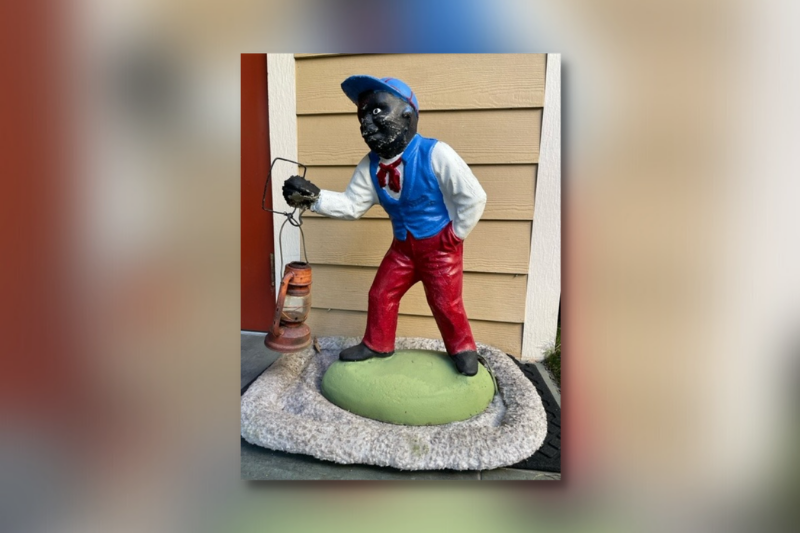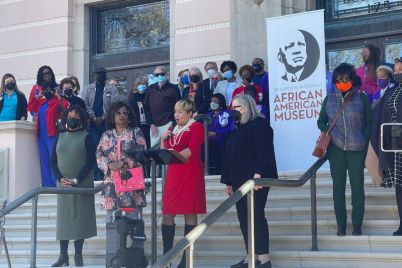The subservient Black yard ornaments were used as markers throughout the Underground Railroad. If a green ribbon were tied to the arms of the statue, it meant safety, and if a red ribbon were present, it meant to keep going.
BY DACIA JACKSON | Teen Journalist
“If you hear the dogs, keep going. If you see the torches in the woods, keep going. If there’s shouting after you, keep going. Don’t ever stop. Keep going. If you want a taste of freedom, keep going.” — Harriet Tubman
As we enter Black History month, it is essential to look to the future of equality as much as the fight it took to get where we are. The battle for justice is not nearly over, but we have come a long way. Though the Underground Railroad was only a part of the fight for freedom, it was still an important part that led up to the Civil War, which ended slavery.
Defined by History.com: “The Underground Railroad was a network of people, African American as well as white, offering shelter and aid to escaped enslaved people from the South.”
As they put it, it acted as a bridge between enslavement and liberity. The Underground Railroads were not actually railroads. They were paths, signs, songs, and quilts that showed where danger was and where freedom could be found.
When you think about it, the Underground Railroad was primarily made up of conductors — the same conductors who saved approximately 100,000 enslaved persons from servitude. Three of the most famous conductors were Harriet Tubman, Fredrick Douglass, and John Brown.
Harriet Tubman has been recognized for her daring missions to help the enslaved escape from plantations all over southeast America. Some sources even described her as the first Black female spy, and others referred to her as “Moses.”
Her mission for freedom started with freeing her family; however, after creating a new identity in Pennsylvania, she decided to go back and save others. It was clear to Tubman that she could help others escape to a better life.
Tubman led and completed a total of 19 trips back and forth to free the enslaved, helping more than 300 people become free Black men and women. Tubman later met Fredrick Douglas and John Brown throughout her trips. This was the beginning of a friendship with Douglass that lasted until his death.
Harriet Tubman also worked as a cook and nurse, then a scout and spy, to finally become the first woman to lead an expedition with armed soldiers, liberating 700 enslaved persons.
Douglass was another famous conductor on the Underground Railroad. He escaped enslavement at 16 after several failed attempts. After marrying his wife, he joined an anti-slavery society and became a well-known author.
He wrote several books, including the influential book “Narrative of the Life of Frederick Douglass.” This book was supportive of the abolitionist movement and still encourages people to fight for justice. In addition, it provides us with a first-hand perspective of what slavery and living after slavery was like.
It is often referred to when talking about the Underground Railroad and the road to freedom. During the Civil War, Douglass, along with many conductors, worked tirelessly to bring freedom to the enslaved, as well as the right to vote.
Finally, Brown was an abolitionist and conductor. As a youth, Brown’s home was a safe house for the enslaved as they slept during the day and traveled on the railroad during the night.
At 16, Brown left his family home to go to college to become a minister. He eventually left school and became a tanner. After several professional changes, Brown built a house and barn in Pennsylvania with hidden rooms. It is reported that he helped thousands of enslaved individuals on their journey to freedom.
In 1859, Brown and 21 men (16 white and 5 Black) seized control of a U.S. armory in Harpers Ferry, Va., and held a few enslavers hostage. The fight to keep these hostages proved harder than capturing them, resulting in Brown’s capture and the deaths of 10 of his men, including two of his sons. Five of the men escaped the seven were captured and hanged.
Brown was found guilty of treason and hanged.
Of course, many conductors fought tirelessly for freedom and justice. Talking about three specific conductors is not an accurate description or account of the bravery of all conductors. Nonetheless, it is a peek into the Underground Railroad.
From a teen’s perspective, learning more about our history and the journey taken makes me appreciative of the resources and opportunities we currently have. In closing, we should all reflect on these brave individuals who risked their lives to help others. Selfless individuals who will forever be remembered. Heroes!

Dacia Jackson
Dacia Jackson is a teen journalist, author, and artist with aspirations of becoming an attorney. She is currently pursuing an interest in journalism while attending a Florida online school. Dacia is honest, ambitious, and tenacious, so her column will always be truthful, extraordinarily unique, and hopefully impactful.








